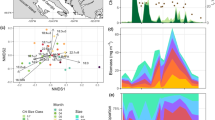Summary
The main features of the size distribution of pelagic and benthic organisms are described, with particular reference to comprehensive studies at a single station, CS2, in the Celtic Sea. These are: 1. A more or less even distribution of biomass in all size classes of pelagic autotrophs. 2. Five size groups of pelagic heterotrophs separated from each other by roughly 103 differences in individual weight, with three well-defined gaps in the size spectrum between the four smallest size modes. 3. Benthic organisms with three size modes, the microbial peak between the two smallest pelagic modes, the meiofaunal peak between the size of pelagic ciliates and herbivorous macrozooplankton, and the macrobenthic peak at about the same size as the carnivorous macrozooplankton. Differences in the positions of the microbial peaks are thought to be associated with the different nutritional environments of free-living and surface-attached bacteria. Other features of the pelagic heterotroph spectrum are explicable in terms of the known limits to size ratios between prey and predator for suspension feeders. These limits do not apply to the benthos, the size distribution of which is largely determined by physical constraints of the sedimentary environment and the optimisation of size-related life history characteristics. Thus, constraints on body size are entirely different in the two systems, and we see little evidence for coupling between the pelagos and benthos which might result in complementary patterns of size distribution, except perhaps for interactions between the pelagic larvae of macrobenthos and the permanent macrozooplankton at the upper end of the size spectrum.
Similar content being viewed by others
References
Alldredge AL, Youngbluth MJ (1985) The significance of macroscopic aggregates (marine snow) as sites for heterotrophic bacterial production in the mesopelagic zone of the subtropical Atlantic. Deep Sea Res 32:1445–1456
Batterton JV, Van Baalen C (1968) Phosphorus deficiency and phosphate uptake in the blue-green alga Anacystis nidulans. Can J Microbiol 14:341–348
Beers JR, Reid FMH, Stewart GL (1975) Microplankton of the North Pacific Central Gyre. Population structure and abundance, June 1973. Int Rev ges Hydrobiol 60:607–638
Beers JR, Reid FMH, Stewart GL (1982) Seasonal abundance of the microplankton population in the North Pacific Central Gyre. Deep-Sea Res 29:227–245
Caron DA, Davies PG, Madin LP, Sieburth JMcN (1982) Heterotrophic bacteria and bacterivorous protozoa in oceanic macroaggregates. Science 218:795–797
Clarke KR, Joint IR (1986) Methodology for estimating numbers of free-living and attached bacteria in estuarine water. Appl Environ Microbiol 51:1110–1120
Estep KW, Davis PG, Keller MD, Sieburth JMcN (1986) How important are oceanic nanoflagellates in bacterivory? Limnol Oceanogr 31:646–650
Fenchel T (1984) Suspended marine bacteria as a food source. In: Fasham MJR (ed) Flows of energy and materials in marine ecosystems. Plenum Press, New York, London, pp 301–315
Fuhrman JA, Azam F (1982) Thymidine incorporation as a measure of heterotrophic bacterioplankton production in marine surface waters: evaluation and field results. Mar Biol 66:109–120
Furnas MJ (1983) Community structure, biomass and productivity of size-fractionated summer phytoplankton populations in lower Narragansett Bay, Rhode Island. J Plankt Res 5:637–654
Hasle GR (1978) Using the inverted microscope. In: Sournia A (ed) Phytoplankton manual. UNESCO, Paris, pp 191–196
Joint IR, Pipe RK (1984) An electron microscope study of a natural population of picoplankton from the Celtic Sea. Mar Ecol Prog Ser 20:113–118
Joint IR, Pomroy AJ (1983) Production of picoplankton and small nanoplankton in the Celtic Sea. Mar Biol 77:19–27
Joint IR, Pomroy AJ (1986) Photosynthetic characteristics of nanoplankton and picoplankton from the surface mixed layer. Mar Biol 92:465–474
Joint IR, Williams R (1985) Demands of the herbivore community on phytoplankton production in the Celtic Sea in August. Mar Biol 87:297–306
Joint IR, Owens NJP, Pomroy AJ (1986) Seasonal production of photosynhetic picoplankton and nanoplankton in the Celtic Sea. Mar Ecol Prog Ser 28:251–258
Kerr SR (1974) Theory of size distribution in ecological communities. J Fish Res Bd Can 31:1859–1862
Koehl MAR, Strickler JR (1981) Copepod feeding currents: food capture at low Reynolds number. Limnol Oceanogr 26:1062–1073
Krempin DW, Sullivan CW (1981) The seasonal abundance, vertical distribution, and relative microbial biomass of chroococcoid cyanobacteria at a station in southern California coastal waters. Can J Microbiol 27:1341–1344
Platt T (1985) Structure of the marine ecosystem: its allometric basis. In: Ulanowicz RE, Platt T (eds) Ecosystem theory for biological oceanography. Dept of Fisheries and Oceans, Ottowa, pp 55–64
Porter KG, Feig YS (1980) The use of DAPI for identifying and counting aquatic microflora. Limnol Oceanogr 25:943–948
Schwinghamer P (1981) Characteristic size distributions of integral benthic communities. Can J Fish aquat Sci 38:1255–1263
Schwinghamer P (1985) Observations on size-structure and pelagic coupling of some shelf and abyssal benthic communities. In: Gibbs PE (ed) Proceedings of the nineteenth European Marine Biology Symposium. Cambridge University Press, Cambridge, pp 347–359
Sheldon RW, Parsons TR (1967) A continuous size spectrum for particulate matter in the sea. J Fish Res Bd Can 24:909–915
Sheldon RW, Prakash A, Sutcliffe WH Jr (1972) The size distribution of particles in the ocean. Limnol Oceanogr 17:327–340
Sheldon RW, Sutcliffe WH Jr, Prakash A (1973) The production of particles in the surface waters of the ocean with particular reference to the Sargasso Sea. Limnol Oceanogr 18:719–733
Sieburth JMcN (1979) Sea Microbes. Oxford University Press, New York, 491 pp
Silver MW, Shanks AL, Trent JD (1978) Marine snow: microplankton habitat and source of small-scale patchiness in pelagic populations. Science 201:371–373
Warwick RM (1984) Species size distributions in marine benthic communities. Oecologia (Berlin) 61:32–41
Warwick RM, Collins NR, Gee JM, George CL (1986) Species size distribution of benthic and pelagic Metazoa: evidence for interaction? Mar Ecol Prog Ser 34:63–68
Wieser W (1953) Die Beziehung zwischen Mundhöhlengestalt, Ernährungsweise und Vorkommen bei freilebenden marinen Nematoden. Ark Zool (2) 4:439–484
Author information
Authors and Affiliations
Rights and permissions
About this article
Cite this article
Warwick, R.M., Joint, I.R. The size distribution of organisms in the Celtic Sea: from bacteria to Metazoa. Oecologia 73, 185–191 (1987). https://doi.org/10.1007/BF00377506
Received:
Issue Date:
DOI: https://doi.org/10.1007/BF00377506




